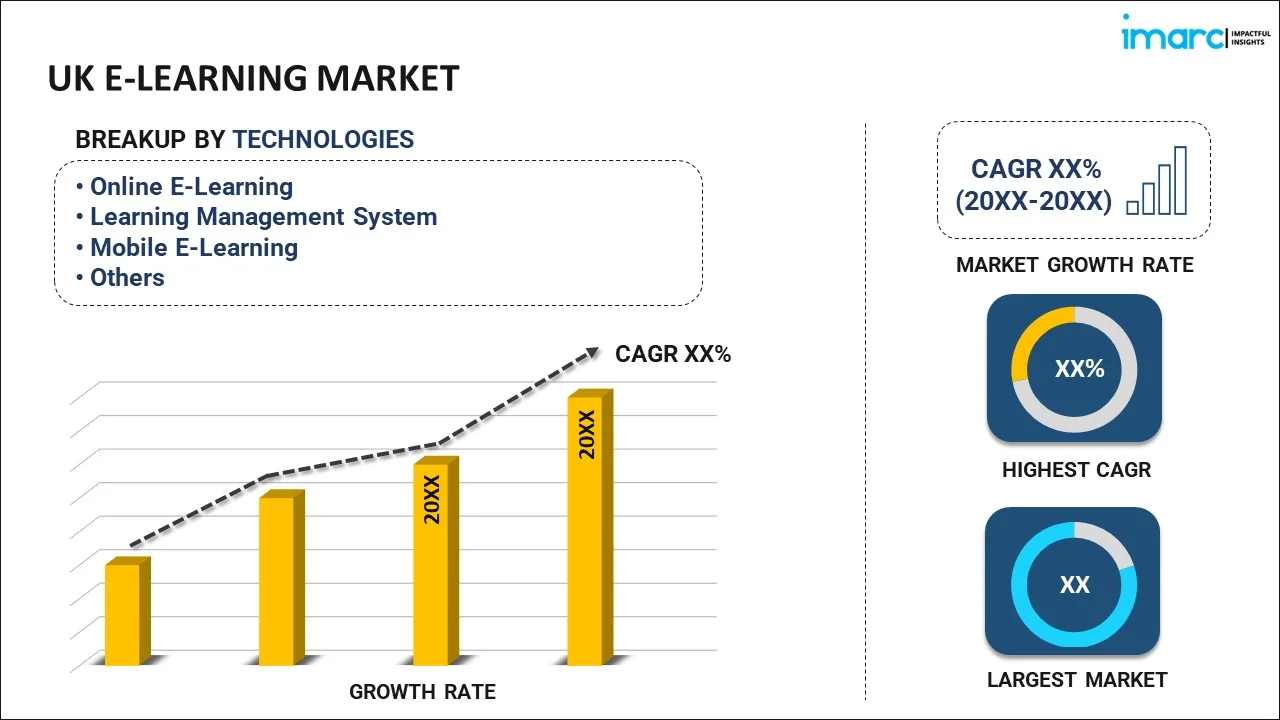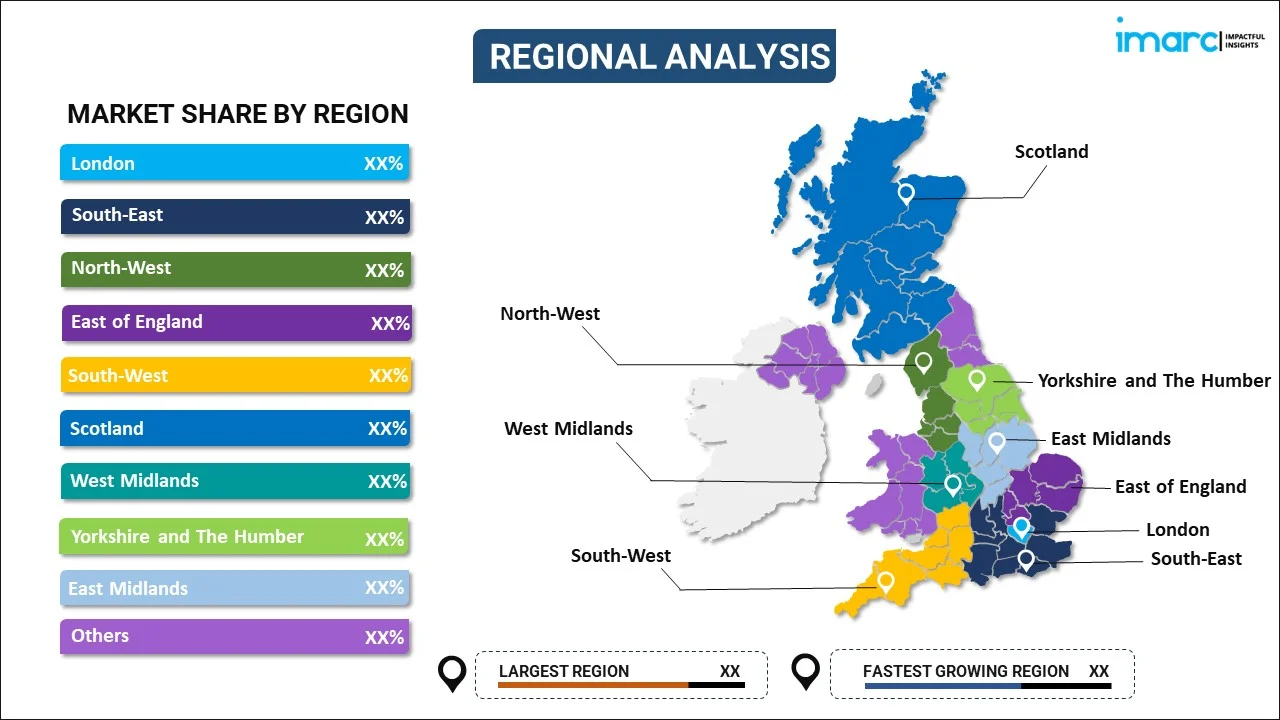
UK E-learning Market Report by Technology (Online E-Learning, Learning Management System, Mobile E-Learning, Rapid E-Learning, Virtual Classroom, and Others), Provider (Services, Content), Application (Academic, Corporate, Government), and Region 2025-2033
UK E-learning Market Overview:
The UK e-learning market size reached USD 11,292.3 Million in 2024. Looking forward, IMARC Group expects the market to reach USD 21,218.8 Million by 2033, exhibiting a growth rate (CAGR) of 7.26% during 2025-2033. The market is expanding due to the increasing utilization of artificial intelligence (AI) and machine learning (ML), rising adoption of smartphones and laptops, emergence of EdTech tools, and focus on corporate training and professional development.
|
Report Attribute
|
Key Statistics
|
|---|---|
|
Base Year
|
2024 |
|
Forecast Years
|
2025-2033
|
|
Historical Years
|
2019-2024
|
| Market Size in 2024 | USD 11,292.3 Million |
| Market Forecast in 2033 | USD 21,218.8 Million |
| Market Growth Rate (2025-2033) | 7.26% |
UK E-learning Market Trends:
Increasing Reliance on Artificial Intelligence (AI) Sector and Machine Learning (ML)
Machine learning (ML) algorithms can analyze vast amounts of learner data to personalize the learning experience. By understanding individual learning styles, preferences, and proficiency levels, e-learning platforms can recommend tailored content, adapt learning paths, and provide targeted feedback, enhancing learner engagement and outcomes. In addition, AI-based content generator tools use natural language processing and ML algorithms to create, filter, and sort knowledge materials. They can include options for designing quizzes, tests, tutorials, and even simulations that can save teachers’ time and let them concentrate on the development of learning activities.
Moreover, AI-driven adaptive learning systems adjust the pace, difficulty, and content of courses based on learners' performance and progress. By continuously analyzing learner interactions and outcomes, these systems can dynamically adapt learning activities to address individual learning needs and optimize learning outcomes, fostering deeper understanding and retention of concepts. As per the International Trade Administration report of 2023, the UK AI market is valued at over $21bn, and it is estimated to grow to over $1tn by 2035.
Increasing Adoption of Smartphones and Laptops
The widespread ownership of smartphones and laptops ensures that learners have easy access to e-learning resources anytime, anywhere. Whether at home, work, or on the go, individuals can access educational materials, participate in online courses, and engage with learning content using their preferred devices, democratizing access to education and training opportunities. Moreover, the aspect of mobility is derived from the premise that e-learning using smartphones and laptops means learners can learn while they have access to multi-media and interactive and collaborative learning facilities. This allows learners to schedule their e-learning activities according to the most convenient time for them, allowing them to incorporate e-learning activities into their busy schedules thus better replicating education for the working adult learner, the college learner or the continuing learner. Apart from this, mobile learning is growing because of the increasing use of smartphones which allows the learner to receive educative content and learning activities directly in their smartphones. According to the Government of U.K. report of 2023, 91% of adults in England owned a smartphone and 62% owned laptop computer.
UK E-learning Market News:
- October 12, 2023: City and Guilds Group collaborated with Future Skills Coalition to create the Skills Hub at the Conservative and Labor conferences to fulfill the commitment of lifelong learning.
- January 25, 2024: D2L, a global learning technology company transforming the way the world learns, announced that the British Council, the United Kingdom’s (UK) international organization for cultural relations and educational opportunities, selected D2L Brightspace in October 2023 as its new learning management system (LMS).
UK E-Learning Market Segmentation:
IMARC Group provides an analysis of the key trends in each segment of the market, along with forecasts at the country level for 2025-2033. Our report has categorized the market based on technology, provider, and application.
Technology Insights:

- Online E-Learning
- Learning Management System
- Mobile E-Learning
- Rapid E-Learning
- Virtual Classroom
- Others
The report has provided a detailed breakup and analysis of the market based on the technology. This includes online e-learning, learning management system, mobile e-learning, rapid e-learning, virtual classroom, and others.
Provider Insights:
- Services
- Content
A detailed breakup and analysis of the market based on the provider have also been provided in the report. This includes services and content.
Application Insights:
- Academic
- K-12
- Higher Education
- Vocational Training
- Corporate
- Small and Medium Enterprises
- Large Enterprises
- Government
The report has provided a detailed breakup and analysis of the market based on the application. This includes academic (K-12, higher education, and vocational training), corporate (small and medium enterprises and large enterprises), and government.
Regional Insights:

- London
- South East
- North West
- East of England
- South West
- Scotland
- West Midlands
- Yorkshire and The Humber
- East Midlands
- Others
The report has also provided a comprehensive analysis of all the major regional markets, which include London, South East, North West, East of England, South West, Scotland, West Midlands, Yorkshire and The Humber, East Midlands, and Others.
Competitive Landscape:
The market research report has also provided a comprehensive analysis of the competitive landscape. Competitive analysis such as market structure, key player positioning, top winning strategies, competitive dashboard, and company evaluation quadrant has been covered in the report. Also, detailed profiles of all major companies have been provided.
UK E-Learning Market Report Coverage:
| Report Features | Details |
|---|---|
| Base Year of the Analysis | 2024 |
| Historical Period | 2019-2024 |
| Forecast Period | 2025-2033 |
| Units | Million USD |
| Scope of the Report | Exploration of Historical Trends and Market Outlook, Industry Catalysts and Challenges, Segment-Wise Historical and Future Market Assessment:
|
| Technologies Covered | Online E-Learning, Learning Management System, Mobile E-Learning, Rapid E-Learning, Virtual Classroom, Others |
| Providers Covered | Services, Content |
| Applications Covered |
|
| Regions Covered | London, South East, North West, East of England, South West, Scotland, West Midlands, Yorkshire and The Humber, East Midlands, Others |
| Customization Scope | 10% Free Customization |
| Post-Sale Analyst Support | 10-12 Weeks |
| Delivery Format | PDF and Excel through Email (We can also provide the editable version of the report in PPT/Word format on special request) |
Key Questions Answered in This Report:
- How has the UK e-learning market performed so far and how will it perform in the coming years?
- What is the breakup of the UK e-learning market on the basis of technology?
- What is the breakup of the UK e-learning market on the basis of provider?
- What is the breakup of the UK e-learning market on the basis of application?
- What are the various stages in the value chain of the UK e-learning market?
- What are the key driving factors and challenges in the UK e-learning?
- What is the structure of the UK e-learning market and who are the key players?
- What is the degree of competition in the UK e-learning market?
Key Benefits for Stakeholders:
- IMARC’s industry report offers a comprehensive quantitative analysis of various market segments, historical and current market trends, market forecasts, and dynamics of the UK e-learning market from 2019-2033.
- The research report provides the latest information on the market drivers, challenges, and opportunities in the UK e-learning market.
- Porter's five forces analysis assist stakeholders in assessing the impact of new entrants, competitive rivalry, supplier power, buyer power, and the threat of substitution. It helps stakeholders to analyze the level of competition within the UK e-learning industry and its attractiveness.
- Competitive landscape allows stakeholders to understand their competitive environment and provides an insight into the current positions of key players in the market.
Need more help?
- Speak to our experienced analysts for insights on the current market scenarios.
- Include additional segments and countries to customize the report as per your requirement.
- Gain an unparalleled competitive advantage in your domain by understanding how to utilize the report and positively impacting your operations and revenue.
- For further assistance, please connect with our analysts.
 Request Customization
Request Customization
 Speak to an Analyst
Speak to an Analyst
 Request Brochure
Request Brochure
 Inquire Before Buying
Inquire Before Buying




.webp)




.webp)












